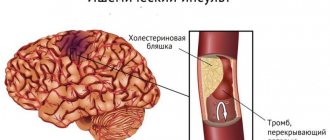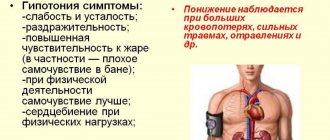Panic attacks and symptoms
Quite often, panic disorder is disguised as other diseases, which makes it difficult to quickly diagnose the disease. Patients experience the same sensations that appear in real neurological, cardiovascular and other serious pathologies.
A person who has recently experienced panic disorder, as a rule, does not know about it, so he often turns to doctors of various specializations for help. The patient is prescribed various examinations of the body, and in the end it turns out that he has no pathologies of internal organs, but despite this, the symptoms of a non-existent disease continue, even intensifying over time. In this case, we can talk about the presence of a panic attack or panic disorder.
Signs of a panic attack
The signs of this disease in most cases have a pronounced physical characteristic; the symptoms are similar to a heart attack, so many patients suspect heart pathology. However, even strong vegetative manifestations in this case are a consequence of dysfunctions of the nervous system and brain.
The main symptoms of a panic attack are anxiety attacks, which are accompanied by autonomic disorders (rapid heartbeat, chills, sweating). With an increase in the level of anxiety, the physiological parameters of the body, which are situational in nature, are often disrupted.
The severity of anxiety varies from a state of internal tension to pronounced panic and fear of death. The average duration of an attack is 15-30 minutes. Anxiety reaches its maximum in the first 5-10 minutes and goes away as suddenly as it started.
Sometimes a panic attack develops against the background of situations that are uncomfortable for a person: being in a crowd or in a confined space.
For some people, attacks occur several times a day, for others - 1-2 times a month. Panic attacks often occur during the daytime. At night, anxiety attacks are more likely to bother strong-willed people who control their feelings while awake.
Stress and hypertension: a psychologist's view
Home — For the public
- Map of medical organizations
- Vaccination
- Clinical examination
- Fluorography
- Addresses and opening hours of clinics
- Emergency rooms
- Oncology
- Where to take an HIV test
- Healthy child's office
- Services
- Prevention of CVD
- Disease Prevention
- World Patient Safety Day
- Newspaper "Medical News"
- specialist
- School of Health
— Disease prevention
- HIV infection
- All about vaccination
- All about proper nutrition
- Hepatitis
- Flu
- Dementia
- Schoolchildren's health
- STD
- Tick-borne encephalitis
- Whooping cough
- Measles
- Legionellosis
- Meningococcal infection
- Oncology
- Acute intestinal infection
- Pediculosis
- First aid
- Pneumococcal infection
- Pneumonia
- Prevention of rabies
- Dependency Prevention
- Rotavirus infection
- Diabetes
- Cardiovascular diseases
- Injuries
- Tuberculosis
- Tularemia
- Physical activity
- Obstructive pulmonary disease
- Exotic infections
- Ecology
- Why is swimming in ponds dangerous?
— Cardiovascular diseases — Blood pressure and stress: a psychologist’s view
In 1935, the American physician and psychoanalyst Helen Flanders Dunbar’s book “Emotions and Somatic Changes” was published, in which she sought to show the connection between personality characteristics and physical diseases: thus, in her opinion, the hypertensive personality type is characterized by:
- increased anger, intolerance, irritability;
- strong internal tension
- strong involvement in work, the ability to struggle for a long time to achieve a goal even with significant resistance from the outside;
- a pronounced need for approval from others, especially authority figures or leaders;
- ambition, need for competition;
- excessive responsibility, perfectionism.
In 1959, American cardiologists R. Rosenman and M. Friedman described and called the behavior of this type of personality “type A behavior,” adding to Dunbar’s theory: a person with “type A” behavior is often dissatisfied with himself and is strict with himself. Such people often do not pay attention to their ailments; if necessary, they work even when they feel unwell. They are characterized by excessive tension in the facial muscles, haste, “explosive” speech, a constant feeling of lack of time, “exhaustive” activities, and inability to rest.
In the early 70s, M. Friedman and R. Rosenman obtained evidence that type A behavior is a risk factor for diseases such as myocardial infarction and angina.
Stress researchers offer tips to help Type A types allocate their resources more realistically and achieve balance in their lives.
- Learn to put off solving problems until you are able to cope with them: people prone to stress often cannot distract themselves, continuing to revolve in a circle of problems, worrying about unlikely opportunities, not solving the problem, but only aggravating their condition.
- Learn to relax to give your body and mind a break from physical and psychological stress: replace intense physical exercise with calm, relaxing exercises.
- Develop the ability to see the events of your life as a whole, without losing a broad perspective or getting bogged down in the small details of a situation.
- Manage the development of stressful situations by implementing realistic planning; Don't get lost when problems arise. Be prepared to face difficulties, do not run away from difficulties.
- Know your limits and don't allow yourself to overexert yourself. A certain level of exercise is beneficial and stimulating, but excess exercise is risky for health.
- Be in touch with your feelings, be able to understand and accept them.
- Many people who are greatly affected by stress spend much of their energy worrying about what others think.
- Remember, “Murphy’s Laws”: if there is a possibility that some kind of trouble can happen, then it will definitely happen. Don't lose your sense of humor and common sense.
- Maintain a balanced attitude towards different areas of life: work, hobbies, family.
Symptoms of a panic attack
- hyperhidrosis (excessive sweating);
- muscle tremors, chills;
- tachycardia;
- dystonic or physiological tremor;
- hot flashes (instant sensations of heat);
- asphyxia (suffocation);
- dyspnea (difficulty breathing, shortness of breath, feeling of lack of air);
- irradiation of pain to the left side of the chest;
- nausea, urge to vomit;
- abdominal pain syndrome (stomach pain);
- sensation of a foreign body, coma in the throat;
- paresthesia (tingling in the limbs, feeling of numbness);
- lightheadedness, dizziness;
- stool disorders (constipation, diarrhea);
- dysbasia (gait disturbance);
- high blood pressure;
- impairment of vision and/or hearing;
- frequent urination.
- derealization (feeling of unreality, alienation, indistinctness of the surrounding reality);
- fear of schizophrenia, obsessive fear of going crazy, losing control over one’s actions;
- disorientation, confusion;
- depersonalization (the patient perceives his actions as if from the outside and feels that he cannot control them);
- interrupted sleep, insomnia (insomnia), nightmares;
- Thanatophobia (fear of death).
- more frequent repetition of attacks with the appearance of new symptoms;
- isolated attacks;
- the addition of depressive symptoms (sleep disturbances, loss of appetite, persistently depressed mood);
- constant fear for your health;
- refusal to perform habitual life rituals (patients stop traveling in public transport, going outside, and their performance sharply decreases).
What does a person experience during a panic attack?
- feeling of fear of varying strength;
- feeling of impending danger;
- fear of death;
- stiffness reaching the point of stupor (in some people);
- motor activity (in others);
- fear of committing an uncontrollable act;
- fear of going crazy;
- confusion of thoughts;
- unreality of what is happening;
- loss of orientation in personality, space and time.
Physical symptoms of a panic attack
The main reason for their appearance is the release of biologically active substances (norepinephrine and adrenaline) into the blood in large quantities. Mediators have a stimulating effect on the nervous, respiratory systems, heart and blood vessels.
- Rapid breathing and heart rate.
- Shortness of breath, lack of air.
- Chills.
- Dry mouth.
- Increased sweating.
- Weakness, body numbness, dizziness.
- Diarrhea.
- Involuntary urination.
- Vomit.
The most pronounced physical symptoms are in anxiety, which develops due to pathology of organs and systems.
- What is stress?
- Increased blood pressure in response to stress as an adaptation
- Increased blood pressure due to chronic stress or failure to adapt
- How to correctly assess your blood pressure level during stress?
What is stress?
According to the classical definition, stress in medicine is a nonspecific reaction of the body that occurs as a response to various physical factors and strong emotions (stressors) that threaten to disrupt the stable state of the body, and leads to characteristic changes in the nervous and endocrine systems.
It is widely believed that stress is always bad for a person. But in fact, stress performs the most important protective and adaptive function, it triggers processes that allow you to survive a stressful situation with the least losses and emerge victorious. Only repeated, chronic stress poses a real danger [1].
This difference is clearly visible if we consider the effect of stress on blood pressure as an example.
Increased blood pressure in response to stress as an adaptation
Consider the classic situation where a person needs to publicly present and then discuss a project with colleagues.
The feeling of excitement and emotional tension increases, and the body reacts to this by releasing many hormones. Adrenaline, norepinephrine and cortisol lead to increased heart rate, increased blood pressure, increased blood flow speed, and increased blood glucose levels. Such changes lead to an improvement in the blood supply to the brain, it absorbs an increased amount of glucose and oxygen from the blood, concentration and concentration increases, the reaction speed increases, which means that the person becomes as collected as possible and ready to answer any question [2]. In this case, in a healthy person, the pressure will be within acceptable limits, not higher than 140/90.
After some time, the discussion of the project ends, the stress factor disappears and the body returns to its original state. Within a few hours, the heart rate decreases and blood pressure normalizes [3]. Thus, with the help of stress, the body successfully adapted to the situation and then returned to a stable state (homeostasis).
Such a short-term increase in pressure can only be harmful if a person suffers from hypertension or other chronic diseases.
Increased blood pressure due to chronic stress or failure to adapt
Let’s assume that the same person has a “dark” streak in his life. First, the child got into trouble at school and had to go to the principal, then an icicle fell on the car and broke through the roof, and then the neighbors flooded the apartment. Because of this, he was late for work the next day, receiving a scolding from his superiors. A day later, his previously approved project was canceled due to lack of funding, and he was transferred to remote work due to the pandemic, depriving him of the opportunity to see his beloved colleagues live.
This series of stressful effects did not allow the body to fully recover, which led to a chronic increase in the level of cortisol, corticosterone and mineralcorticoid hormones in the blood, and these hormones, in turn, contributed to the maintenance of high blood pressure for a long time [5, 7]. As a result, adaptation failed, the body began to consider constantly elevated blood pressure as the norm, and baroceptors responsible for regulating pressure and various body systems responsible for homeostasis adapted to this level [4]. A step was taken towards the development of hypertension.
It is these people who often turn to therapists with complaints like “the pressure is jumping from the nerves” or “they constantly have a headache at work.” After all, any additional stress factor will cause a further increase in the already elevated level of blood pressure, leading to the development of unpleasant symptoms and the risk of a hypertensive crisis [9].
How to correctly assess your blood pressure level during stress?
It is best to measure blood pressure using an accurate automatic blood pressure monitor while sitting, after resting for 10-15 minutes.
During a stressful event and 2-4 hours after it, elevated blood pressure readings may be recorded [9]. However, if a person does not experience severe discomfort, and the numbers do not exceed 140-150 units of systolic (“upper”) pressure and 100 units of diastolic (“lower”) pressure, then this condition can be classified as a normal variant during adaptation to stress.
If the pressure remains high for more than 6 hours, symptoms such as headache, dizziness, tinnitus, blurred vision, nausea are observed, it makes sense to call an ambulance or consult a doctor. Also, a reason to consult a doctor may be persistently elevated blood pressure for several days or the appearance of similar symptoms during any emotional experiences [8].
It is best to monitor your condition using an observation diary, briefly describing what exactly led to the increase in pressure, to what level it rose and what the symptoms were. Such a diary will greatly help the specialist to choose and prescribe the correct treatment. It is most convenient to keep such a diary when the tonometer has a memory function and remembers the results of the latest measurements.
1. Bobkov A.I., Reshetnyak D.V., Nikushkin E.V. About compensated and decompensated hormonal and biochemical disorders during clinical stress // Klin. lab. diag. – 2009. – No. 9. – P. 42–43 2. Buijs, R. M., & Van Eden, C. G. (2000). The integration of stress by the hypothalamus, amygdala and prefrontal cortex: balance between the autonomic nervous system and the neuroendocrine system. Cognition, Emotion and 3. Autonomic Responses: The Integrative Role of the Prefrontal Cortex and Limbic Structures, 117–132. 4. Yaribeygi, H., Panahi, Y., Sahraei, H., Johnston, T. P., & Sahebkar, A. (2017). The impact of stress on body function: A review. EXCLI journal, 16, 1057–1072. 5. McEwen BS (2006). Protective and damaging effects of stress mediators: central role of the brain. Dialogues in clinical neuroscience, 8(4), 367–381. 6. Ostroumova, O.D., & Kochetkov, A.I. (2018). Worksite hypertension as a model of stress-induced arterial hypertension. Terapevticheskii arkhiv, 90(9), 123–132. 7. Strizhakov, LA, Babanov, SA, Lebedeva, MV, Moiseev, SV, & Fomin, VV (2018). Arterial hypertension at the workplace: risk factors and the population value. Terapevticheskii arkhiv, 90(9), 138–143. 8. Antonov, E. V., Markel', A. L., & Yakobson, G. S. (2011). Aldosterone and stress-dependent arterial hypertension. Bulletin of experimental biology and medicine, 152(2), 188–191. 9. Akagi, S., Matsubara, H., Nakamura, K., & Ito, H. (2018). Modern treatment to reduce pulmonary arterial pressure in pulmonary arterial hypertension. Journal of cardiology, 72(6), 466–472. 10. Heine, H., & Weiss, M. (1987). Life stress and hypertension. European heart journal, 8 Suppl B, 45–55.
Author
Kasabov K.A.,
Lecturer at the First Moscow State Medical University named after I.M. Sechenov, researcher at the Research Institute of Pharmacology named after. V.V. Zakusova.
blood pressurehuman blood pressure increasedsevere stressreduce pressurestress causeanxiety feelingperson stress
Share this article with your friends
What is the mechanism of stress and how does it affect hypertension?
To understand how stress forms and develops and what its effect on hypertension is, you need to know basic facts about the structure of the human body:
- The cervical vertebrae have processes along which the coronary arteries run. They carry blood, oxygen and beneficial microelements to the brain through the basal region into the rhomboid fossa.
- The fossa contains the center for regulating blood pressure, heart rate, pulse and blood vessel tone.
- Between the processes of the cervical vertebrae there are vertebral intertransverse muscles, which affect many vital processes.
Nature has provided for humans such a phenomenon as atavism - reflexes left over in the process of evolution. One of the main atavisms of a person is the instinctive protection of the neck. Previously, this instinct helped ancestors protect themselves from predators. Now reflexive protection of the neck is manifested in any stressful situations. For example, in fear we pull our heads into our shoulders, when we receive bad news we hang our noses, and in a confused state we slouch. The neck, like a sponge, absorbs all experiences, becoming a source of hypertension.
Stress is a tense state of the body, which is accompanied by characteristic symptoms:
- Physical - migraine, headache, sleep disturbance, stooped posture, fatigue, increased muscle tone, excess weight;
- Mental - phobias, nervous tension, anxiety, memory loss, decline in performance, lack of concentration;
- Emotional - psychosis, depression, tearfulness, mood swings, lack of a sense of humor, irritability, negative emotions, mania;
- Behavioral - lack of physical activity, excess physical activity, tendency to overeat, abuse of smoking, alcohol, drugs, intensive work schedule.
As you know, all these factors are considered to be the causes of hypertension. Due to stress, the main load falls on the neck, after which the consequences spread to the heart, brain, kidneys, blood vessels, and retina. Coronary arteries, compressed by the intertransverse muscles and cervical vertebrae, prevent sufficient oxygen from entering the brain stem, the vessels narrow, and the pressure rises.
Stress also promotes the production of the hormones adrenaline and cortisol. Hormones are an integral part of the human body, but in moderation. In stressful situations, the adrenal glands secrete an increased dose of adrenaline, which affects blood pressure.
Join the
Club of Former Hypertensive Patients
, download gymnastics that has already helped hundreds of thousands of people overcome pressure surges and hypertension. Get the most current and correct information about problems related to blood pressure, osteochondrosis, atherosclerosis, ask your questions to Dr. Shishonin and just communicate.











